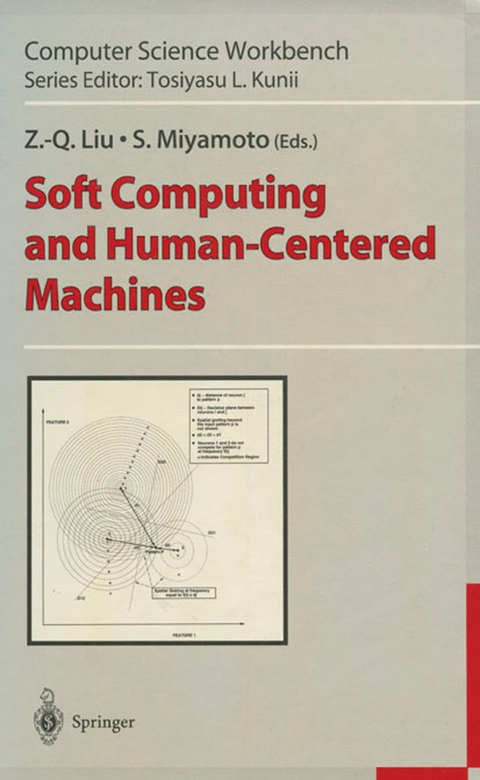
Soft Computing and Human-Centered Machines
Springer Verlag, Japan
978-4-431-67986-8 (ISBN)
1 Introduction.- 1.1 The Third Industrial Revolution: human-centered machines.- 1.2 Soft Computing: a unifying framework for intelligent systems.- 2 Multisets and Fuzzy Multisets.- 2.1 Introduction.- 2.2 Multisets.- 2.3 Fuzzy Multisets.- 2.4 Infinite Fuzzy Multisets.- 2.5 Another Ftizzification.- 2.6 Application to Query Language for Fuzzy Database.- 2.7 Conclusion.- 2.8 References.- 3 Modal Logic, Rough Sets, and Fuzzy Sets.- 3.1 Introduction.- 3.2 Language for Modal Logic.- 3.3 Kripke Semantics for Modal Logic.- 3.4 Truth Sets and Generalized Lower and Upper Approximations.- 3.5 Validity.- 3.6 What is a System of Modal Logic?.- 3.7 Normal Systems of Modal Logic.- 3.8 Soundness.- 3.9 Completeness.- 3.10 Fuzzy Sets and Rough Sets.- 3.11 Concluding Remarks.- 3.12 References.- 4 Fuzzy Cognitive Maps: Analysis and Extensions.- 4.1 Introduction.- 4.2 Fuzzy Cognitive Maps.- 4.3 Extensions to FCM.- 4.4 Analysis of Fuzzy Cognitive Maps.- 4.5 Conclusions.- 4.6 References.- 5 Methods in Hard and Fuzzy Clustering.- 5.1 Introduction.- 5.2 Basic Methods in Clustering.- 5.3 Fuzzy c-Means.- 5.4 Other Nonhierarchical Methods.- 5.5 A Numerical Example.- 5.6 Fuzzy Hierarchical Clustering.- 5.7 Conclusions.- 5.8 References.- 6 Soft-Competitive Learning Paradigms.- 6.1 Introduction.- 6.2 Learning by Neural Networks.- 6.3 Competitive Learning Paradigm.- 6.4 Overview of Competitive Learning Schemes.- 6.5 Fuzzy Competitive Learning and Soft Competition.- 6.6 Compensated Competitive Learning.- 6.7 Conclusions.- 6.8 References.- 7 Aggregation Operations for Fusing Fuzzy Information.- 7.1 Introduction.- 7.2 Intersection and Union of Fuzzy Sets.- 7.3 Weighted Unions and Intersections.- 7.4 Uninorms.- 7.5 Mean Aggregation Operators.- 7.6 Ordered Weighted Averaging Operators.- 7.7 Linguistic Quantifiers and OWA Operators.- 7.8 Aggregation Using Fuzzy Measures.- 7.9 Conclusion.- 7.10 References.- 8 Fuzzy Gated Neural Networks in Pattern Recognition.- 8.1 Introduction.- 8.2 Generalized Gated Neuron Model.- 8.3 Fuzzy Gated Neural Networks.- 8.4 Comparison between FGNN and STFM.- 8.5 Experimental Results.- 8.6 Improvements to FGNN.- 8.7 The Improved FGNN.- 8.8 Conclusions.- 8.9 References.- 9 Soft Computing Technique in Kansei (Emotional) Information Processing.- 9.1 Introduction.- 9.2 Concept of Kansei Information.- 9.3 Study Examples of Facial Expressions.- 9.4 Conclusions.- 9.5 References.- 10 Vagueness in Human Judgment and Decision Making.- 10.1 Introduction.- 10.2 Theoretical Representation of Vagueness in Judgment and Decision Making.- 10.3 Measurement and Fuzzy-Set Representation of Vagueness in Judgment and Decision Making.- 10.4 Experimental Studies of Vagueness of Judgment and Decision Making Using the Fuzzy Rating Method.- 10.5 Regression Analyses for Fuzzy Rating Data.- 10.6 Conclusion.- 10.7 References.- 11 Chaos and Time Series Analysis.- 11.1 Introduction.- 11.2 Embedding Time Series Data.- 11.3 Deterministic Nonlinear Prediction.- 11.4 Analysis of Complicated Time Series by Deterministic Nonlinear Prediction.- 11.5 Engineering Applications of Deterministic Nonlinear Prediction.- 11.6 Chaotic Time Series Analysis and Statistical Hypothesis Testing.- 11.7 Conclusions.- 11.8 References.- 12 A Short Course for Fuzzy Set Theory.- 12.1 Classical Sets.- 12.2 Fuzzy Sets.- 12.3 Basic Operations on Fuzzy Sets.- 12.4 Extension Principle.- 12.5 Fuzzy Relations.- 12.6 Possibility and Necessity Measures.- 12.7 Fuzzy Numbers.- 12.8 Discussion and Remarks.- 12.9 References.
| Reihe/Serie | Computer Science Workbench |
|---|---|
| Zusatzinfo | 9 Illustrations, black and white; XVIII, 327 p. 9 illus. |
| Verlagsort | Tokyo |
| Sprache | englisch |
| Maße | 155 x 235 mm |
| Themenwelt | Informatik ► Theorie / Studium ► Künstliche Intelligenz / Robotik |
| Schlagworte | Fuzzy Logic • human-centered systems • machine intelligence • machine learning • Soft Computing |
| ISBN-10 | 4-431-67986-3 / 4431679863 |
| ISBN-13 | 978-4-431-67986-8 / 9784431679868 |
| Zustand | Neuware |
| Haben Sie eine Frage zum Produkt? |
aus dem Bereich


